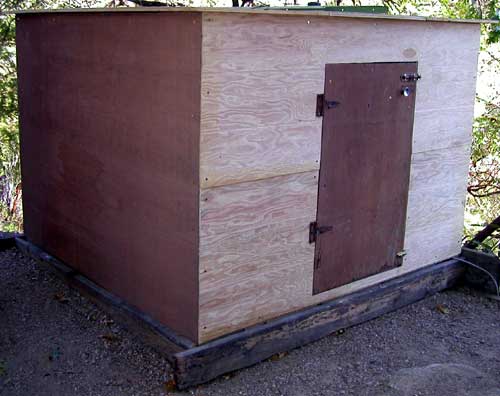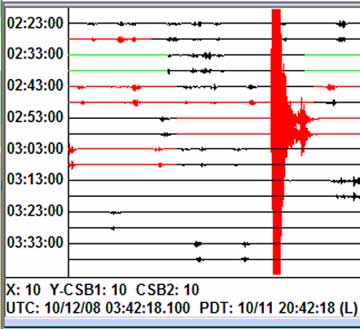
200810.20 - Seismic Shed Re-Construction
200810.20 - 0616 PDT - Completed cable run from computer room to seismic shed for the VolksMeter and started on insulation, which is taking longer than I anticipated (again)... and plugging shed nail holes. To be continued with pictures later.
This weekend I am attempting to finish installing insulation, plus a few other things in the seismic shed, so seismic data will be off-line. If this goal is achieved, the VolksMeter should be On-line by Monday and I can pick up where I left off, before the Northern California fires this past summer.

Yesterday, I finished rough carpentry on the seismic shed rebuild and have two L15B sensors running.
I moved the L15B sensors back to SPS (samples per second) 100 and changed GIF filtering from NONE to Low-Pass Filter 2 Hz - 2 Poles, on both channels, in order to eliminate "road noise", per Larry's advice.
The first preliminary tests were done without insulation (in the shed) and, up until yesterday, had open areas allowing for 'heavy drafts' to pass through openings.
The heliplots on this page reflect before and after pictures of wind noise elimination and now, with the shed mostly sealed, new heliplots will show what the result will be.
On the 'to-do list' for next week, weather permitting, is filling all old nail holes with wood putty, installing insulation, and painting a coat of waterproof primer on the shed. After these things are completed I will move the VolksMeter back into the shed and today, will attempt to install new RS-232 cable for it. (fwiw) Down the road I intend to try a RS-232 transmitter/receiver to see if I can eliminate long runs of cable.
(btw) I noticed helicopter noise had been reduced to half the size of original (old shed) noise shown on heliplots and look forward to seeing if insulation reduces this noise some more.
(fwiw) One of the reasons why the shed took so long to rebuild was because I replaced all nails with screws and bolts. The new shed can be taken apart and moved.
Finally, when it happens, it will happen; meaning, ;-) I have an interesting art design for the shed (-; but may wait until next spring to add it.
[UPDATED - New Information == Note: '6 Hz' '4 Pole' Low-pass filters have been added to ARPSN-1 (L15B sensors), which eliminate noise on heliplots. I changed these from 2 Hz 2 Poles to make heliplots more interesting
Trace lines will remain flat until a local >= 1.0 magnitude earthquake occurs. Flat red traces represent 1.0 magnitude or less.

From now on heliplots will appear different. The above image (at bottom) is an older example of a new heliplot showing a single red vertical spike.
The below WinSDR image (normally located at bottom of weather pictures) corresponds with above heliplot, showing original 2.3 magnitude data trace received here, which is larger than the heliplot image. [Green traces represent OFF-LINE.]

The vertical spike represents a 2.3 Magnitude earthquake at "The Geysers" and appears on this USGS list:
http://quake.usgs.gov/recenteqs/Quakes/quakes0_fault.htm
on this map:
http://quake.usgs.gov/recenteqs/FaultMaps/123-39.htm
USA list:
http://earthquake.usgs.gov/eqcenter/recenteqsus/Quakes/quakes_all.php
World list:
http://earthquake.usgs.gov/eqcenter/recenteqsww/Quakes/quakes_all.php
ARPSN-1 Alerts are intended to begin at >= 5.0 magnitude in our (as of now, undefined) local area and the 'yet to be installed' sensors will cover teleseismic and LFE (low-frequency earthquake) events.